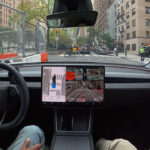Society of Automotive Engineers (SAE) has decided to standardize the EV charging connector design to the Tesla-developed North American Charging Standard (NACS). SAE made this announcement in a press release about 2 months ago but it widely went unnoticed.
Vehicle teardown expert and automotive engineer Sandy Munro brought the SAE’s decision to light via a short video on the social media platform X last week. According to Munro, this is big news for the EV industry as a whole, at least in North America.
SAE took the decision to standardize the Tesla connector after Ford announced the integration of the NACS charge port in their future EV production. Weeks later, General Motors (Chevrolet, GMC, Cadillac, Buick, Vauxhall) and Rivian also agreed to standardize the NACS charging connector for their electric vehicles followed by Mercedes-Benz (Daimler AG).
SAE’s standardization of the NACS means that EV charging companies across North America will be adopting the standard. Since SAE’s announcement EV charging providers such as Electrify America, EVgo, ChargePoint, and more have announced to integrate the Tesla NACS at their charging stations in the near future.
According to the SAE International press release, the adoption of the Tesla NACS standardization will be made in an expedited timeframe, meaning it will not take years to make it happen. SAE’s press release stated the following:
“Standardizing the NACS connector will provide certainty, expanded choice, reliability and convenience to manufacturers and suppliers and, most of all, increase access to charging for consumers,” said Frank Menchaca, president of Sustainable Mobility Solutions, an innovation arm of SAE affiliate Fullsight. The organization in a statement credited the U.S.’s Joint Office of Energy and Transportation for fostering the SAE-Tesla partnership and “expediting plans to standardize NACS – an important step in building an interoperable national charging network that will work for all EV drivers.
Although Tesla dubbed the NACS connector a “standard,” it is not one that had been reached through industry consensus. The SAE standardization process is intended to assure reliable and consistent performance for any EV model or charging network.”

As we can see in the picture above which shows the difference between a J1772 CCS and a Tesla NACS connector, the Tesla connector is lightweight, smaller in size, and has a less complicated design. According to Sandy Munro, anyone used to charging with a Tesla connector knows that any other connector is ‘goofy in comparison’.
However, both the SAE J1772 (CCS Type 1) and Tesla V4 NACS connector have similar max output capacities, 360 kW and 350 kW respectively. The most widely available Tesla Supercharger V3 connectors are able to output a maximum of 250 kW of power.
The normalization of a single standard of electric vehicle charging across North America will act as a catalyst for the expansion of sustainable transportation in the region. This, of course, is not possible until all parties including the governments put in their efforts. The good news is that last month, the state of Kentucky mandated the requirement of Tesla NACS charging connectors to be present at all government-funded charging stations. This move by Kentucky should set a good example for other states to follow.
Tesla opening its charging connector design last year proved to be a good omen and it received a warm welcome from the automotive industry and the EV charging companies alike. Widespread adoption of the NACS charging standard should also help reduce the range anxiety for existing and potential EV owners across North America.
New EV manufacturing startups like Rivian will also greatly benefit from the Tesla NACS connector and charge port design because it will eliminate the need to build their own charging network. Adopting the NACS standard, OEMs can potentially save billions of dollars they would otherwise use to build an EV charging network. On the other hand, a new revenue stream will open for Tesla and a chance for free advertisement to non-Tesla EV owners.
Related
- Tesla FSD v14.2.1 conquers ‘The Snake’ highway in California (hairpin turns, ~30 curves, video)
- Tesla FSD v14.2.1 recognizes hand gestures and proceeds a red light and more (videos)
- License Tesla FSD or face the disruption — Musk once again warns legacy automakers
- Tesla offers 30-day FSD v14 trials to HW4 vehicles in North America, FSD v14.2 goes wide release
- Tesla update 2025.44 goes wide with Radio Traffic Announcements, dashcam tweaks, preps for Holiday Update (Release Notes)
- Tesla FSD v14.2 modifies how you select Speed Profiles and Arrival Options









Picture showing the J1772 plug end, it’s missing the two extra large DC fast charging terminals that are below what this picture shows. With those two extra large DC connectors it’s obvious that Tesla’s is much smaller and better essentially, but without this being shown it’s not obvious at all…